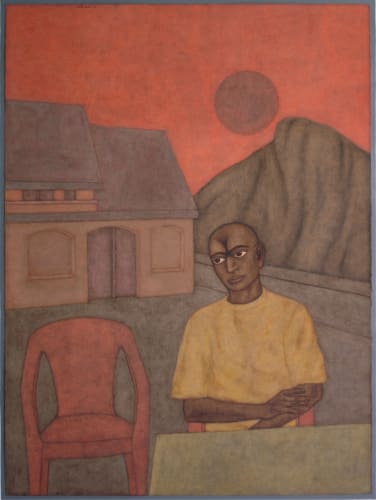" Shanti Panchal is primarily a painter of people"
- Andrew Lambirth, 2024
Shanti Panchal is primarily a painter of people. The use of clear outlines and silhouettes, with emphasis on eyes, is typical of the tradition of Jain manuscript illustration from southern India. Panchal draws upon this in both the flatness of his imagery and the large-eyed wonder of his protagonists. This is not a startled glance but an ineffably calm gaze, indicative of a stoic inner spiritual vitality. Similarly, the shaven-headed men evoke the monkish look of the religious initiate. But Panchal's work is not simply a contemporary version of a centuries old tradition: his approach is informed by long residence in London and by his study of Western art. Thus he says: 'I like empty, abstract spaces, like large masses of colour. You can relate that to my interest in Bacon and El Greco.' Likewise he is fascinated by the intense visions of William Blake, Samuel Palmer and Mark Rothko.
His imagery builds upon his own life experiences, yet it also manages to achieve the necessary detachment to attain universal significance. Perhaps exile has given him the ability to view both Indian and English culture dispassionately. The rich velvety sheen of his watercolours is a result of the layers of carefully applied paint combining with the textured surface of the paper to make a new and unique whole. There may be 10 or 15 layers of watercolour applied in what the artist calls 'a meditative process' over a period of time in order to achieve and sustain the soft yet vivid glow of these images. His palette of warm earthy spice colours echoes the ochres, reds and browns of the landscape of his native Gujurat, and the built environment of mud-walled houses with red roof tiles.
In terms of visual research, he uses photographs of models, as well as drawings to establish the composition. He relishes the fluency of his line drawings in pencil on imperial sized sheets, but to discover the design of a painting takes at least a week of drawing and re-drawing before he is ready to start painting. Although he paints mostly flat on a table, he has an easel handy so that he can look at work from a distance. And he will also draw on the paper, on a drawing board, when it is upright on the easel. He finds he can work only in natural light, so he puts in longer hours in the summer than winter.
He favours slow art: a large painting can take him many months to resolve. The painting takes time to make, and thus takes time into itself. It embodies the passage of time, in a way that few of today’s instant cultural offerings do. The poise and dignity, the gravitas of his figures, contributes to what one might call the informal grandeur of his images. Shanti Panchal’s paintings of solemn and subtly nuanced colour celebrate the vitality and endurance of the human spirit.
